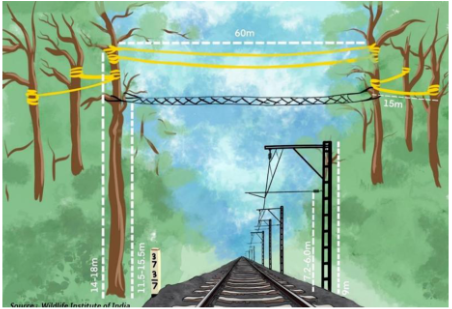Table of Contents
Context: The Standing Committee of the National Board for Wildlife (NBWL) has approved a proposal to carry out oil and gas exploration in the ecosensitive zone of the Hoollongapar Gibbon Wildlife Sanctuary.
The Northeast Frontier Railway (NFR) has allocated funds to build canopy bridges over a railway track that splits the primary habitat of India’s only ape species in eastern Assam.
About Hoollongapar Gibbon Wildlife Sanctuary (WLS)
- It is an isolated protected area of evergreen forest located in Jorhat, Assam.
- It was given WLS status in 1997. It is the only sanctuary in India named after a gibbon.
- River: Bhogdoi River (Tributary of the Brahmaputra) creates a waterlogged area along the sanctuary’s border
- Flora: Hollong tree, Nahar tree (cobra’s saffron) along with evergreen shrubs and herbs.
- Fauna:
- It contains India’s only gibbons–the hoolock gibbons and Northeastern India’s only nocturnal primate–the Bengal slow loris.
- Other species found: Elephants, tigers, leopards, stump-tailed macaque, northern pig-tailed macaque etc.
Canopy Bridges
- A canopy bridge is a type of wildlife crossing that is specifically designed for arboreal (tree-dwelling) species.
- These bridges are constructed above the ground, usually connecting fragmented patches of forest that have been divided by roads, railways, or other human constructions.

Key Features and Benefits of Canopy Bridges
- Habitat Connectivity: Canopy bridges are crucial for restoring and maintaining habitat connectivity in fragmented landscapes.
- They allow animals to move freely between different areas of their habitat, which is vital for accessing resources, finding mates, and maintaining healthy populations.
- Reduction in Wildlife Mortality: By providing a safe route over dangerous obstacles like roads and railway tracks, canopy bridges help reduce the risk of wildlife-vehicle collisions, which are a significant threat to many species.
- Genetic Diversity: The bridges facilitate gene flow between isolated populations, which is essential for preventing inbreeding and ensuring long-term genetic diversity, crucial for the species’ resilience to environmental changes.
- Design and Implementation: The construction of canopy bridges can be adapted to various environments and budgets, ranging from simple rope bridges to more sophisticated structures that mimic natural forest canopies.
About Hoolock Gibbon
- Hoolock Gibbons, renowned for being the smallest and swiftest apes, reside in the tropical and subtropical forests of Southeast Asia.
- They are highly intelligent, exhibit unique personalities, and maintain strong familial ties, common traits in apes.
- They are among the 20 species of gibbons globally and are the sole ape species found in India.
- Characterised by their prominent white eyebrows, elongated arms, and a throat pouch used for vocalising.

Arboreal Lifestyle and Challenges
- Tree-Dwelling Habits: Gibbons are entirely tree-dwelling, spending their existence in the forest canopies.
- Sensitivity to Habitat Changes: They are acutely affected by disruptions in their habitat, such as breaks in the canopy.
- Risks of Habitat Fragmentation: Habitat division can cause genetic isolation and pose a risk to their populations.
Gibbon Varieties in India
Western Hoolock Gibbon (Hoolock hoolock)
- Geographic Spread: Found across northeastern India, specifically south of the Brahmaputra River and east of the Dibang River, and also in eastern Bangladesh and northwest Myanmar.
- Conservation Status: Classified as ‘Endangered’ on the IUCN Red List.
Eastern Hoolock Gibbon (Hoolock leuconedys)
- Habitat: Inhabits areas in Arunachal Pradesh and Assam in India, and regions in southern China and northeast Myanmar.
- Conservation Status: Listed as ‘Vulnerable’ on the IUCN Red List.
Note: Both species are protected under Schedule 1 of the Indian (Wildlife) Protection Act of 1972.
| National Board for Wildlife (NBWL) |
|


 Hydrogen For Net-Zero Economy, Governmen...
Hydrogen For Net-Zero Economy, Governmen...
 Mantis Shrimp - Latest Research News and...
Mantis Shrimp - Latest Research News and...
 Places in News for UPSC 2025 for Prelims...
Places in News for UPSC 2025 for Prelims...





















